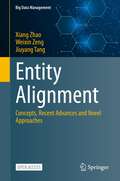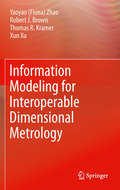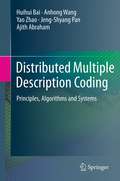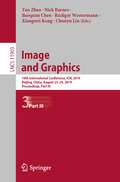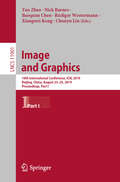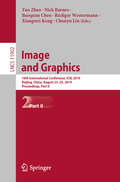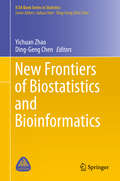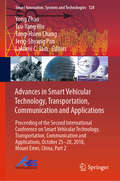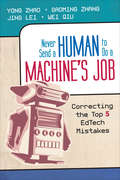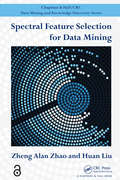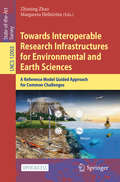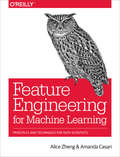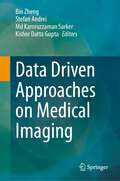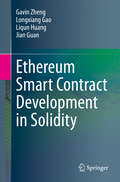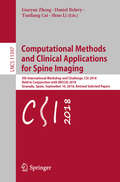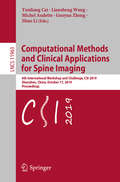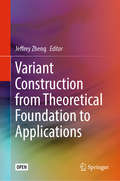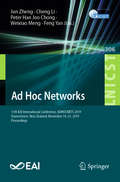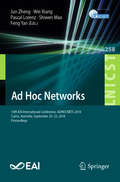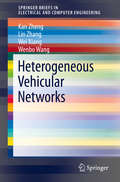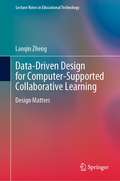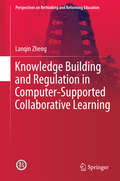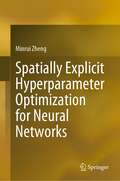- Table View
- List View
Entity Alignment: Concepts, Recent Advances and Novel Approaches (Big Data Management)
by Xiang Zhao Weixin Zeng Jiuyang TangThis open access book systematically investigates the topic of entity alignment, which aims to detect equivalent entities that are located in different knowledge graphs. Entity alignment represents an essential step in enhancing the quality of knowledge graphs, and hence is of significance to downstream applications, e.g., question answering and recommender systems. Recent years have witnessed a rapid increase in the number of entity alignment frameworks, while the relationships among them remain unclear. This book aims to fill that gap by elaborating the concept and categorization of entity alignment, reviewing recent advances in entity alignment approaches, and introducing novel scenarios and corresponding solutions.Specifically, the book includes comprehensive evaluations and detailed analyses of state-of-the-art entity alignment approaches and strives to provide a clear picture of the strengths and weaknesses of the currently available solutions, so as to inspire follow-up research. In addition, it identifies novel entity alignment scenarios and explores the issues of large-scale data, long-tail knowledge, scarce supervision signals, lack of labelled data, and multimodal knowledge, offering potential directions for future research. The book offers a valuable reference guide for junior researchers, covering the latest advances in entity alignment, and a valuable asset for senior researchers, sharing novel entity alignment scenarios and their solutions. Accordingly, it will appeal to a broad audience in the fields of knowledge bases, database management, artificial intelligence and big data.
Information Modeling for Interoperable Dimensional Metrology
by Y Zhao Robert Brown T Kramer Xun XuDimensional metrology is an essential part of modern manufacturing technologies, but the basic theories and measurement methods are no longer sufficient for today's digitized systems. The information exchange between the software components of a dimensional metrology system not only costs a great deal of money, but also causes the entire system to lose data integrity. Information Modeling for Interoperable Dimensional Metrology analyzes interoperability issues in dimensional metrology systems and describes information modeling techniques. It discusses new approaches and data models for solving interoperability problems, as well as introducing process activities, existing and emerging data models, and the key technologies of dimensional metrology systems. Written for researchers in industry and academia, as well as advanced undergraduate and postgraduate students, this book gives both an overview and an in-depth understanding of complete dimensional metrology systems. By covering in detail the theory and main content, techniques, and methods used in dimensional metrology systems, Information Modeling for Interoperable Dimensional Metrology enables readers to solve real-world dimensional measurement problems in modern dimensional metrology practices.
Distributed Multiple Description Coding
by Yao Zhao Huihui Bai Jeng-Shyang Pan Ajith Abraham Anhong WangThis book examines distributed video coding (DVC) and multiple description coding (MDC), two novel techniques designed to address the problems of conventional image and video compression coding. Covering all fundamental concepts and core technologies, the chapters can also be read as independent and self-sufficient, describing each methodology in sufficient detail to enable readers to repeat the corresponding experiments easily. Topics and features: provides a broad overview of DVC and MDC, from the basic principles to the latest research; covers sub-sampling based MDC, quantization based MDC, transform based MDC, and FEC based MDC; discusses Sleplian-Wolf coding based on Turbo and LDPC respectively, and comparing relative performance; includes original algorithms of MDC and DVC; presents the basic frameworks and experimental results, to help readers improve the efficiency of MDC and DVC; introduces the classical DVC system for mobile communications, providing the developmental environment in detail.
Image and Graphics: 10th International Conference, ICIG 2019, Beijing, China, August 23–25, 2019, Proceedings, Part III (Lecture Notes in Computer Science #11903)
by Yao Zhao Nick Barnes Baoquan Chen Rüdiger Westermann Xiangwei Kong Chunyu LinThis three-volume set LNCS 11901, 11902, and 11903 constitutes the refereed conference proceedings of the 10thth International Conference on Image and Graphics, ICIG 2019, held in Beijing, China, in August 2019. The 183 full papers presented were selected from 384 submissions and focus on advances of theory, techniques and algorithms as well as innovative technologies of image, video and graphics processing and fostering innovation, entrepreneurship, and networking.
Image and Graphics: 10th International Conference, ICIG 2019, Beijing, China, August 23–25, 2019, Proceedings, Part I (Lecture Notes in Computer Science #11901)
by Yao Zhao Nick Barnes Baoquan Chen Rüdiger Westermann Xiangwei Kong Chunyu LinThis three-volume set LNCS 11901, 11902, and 11903 constitutes the refereed conference proceedings of the 10thth International Conference on Image and Graphics, ICIG 2019, held in Beijing, China, in August 2019. The 183 full papers presented were selected from 384 submissions and focus on advances of theory, techniques and algorithms as well as innovative technologies of image, video and graphics processing and fostering innovation, entrepreneurship, and networking.
Image and Graphics: 10th International Conference, ICIG 2019, Beijing, China, August 23–25, 2019, Proceedings, Part II (Lecture Notes in Computer Science #11902)
by Yao Zhao Xiangwei Kong Nick Barnes Baoquan Chen Rüdiger Westermann Chunyu LinThis three-volume set LNCS 11901, 11902, and 11903 constitutes the refereed conference proceedings of the 10thth International Conference on Image and Graphics, ICIG 2019, held in Beijing, China, in August 2019. The 183 full papers presented were selected from 384 submissions and focus on advances of theory, techniques and algorithms as well as innovative technologies of image, video and graphics processing and fostering innovation, entrepreneurship, and networking.
New Frontiers of Biostatistics and Bioinformatics (ICSA Book Series in Statistics)
by Yichuan Zhao Ding-Geng ChenThis book is comprised of presentations delivered at the 5th Workshop on Biostatistics and Bioinformatics held in Atlanta on May 5-7, 2017. Featuring twenty-two selected papers from the workshop, this book showcases the most current advances in the field, presenting new methods, theories, and case applications at the frontiers of biostatistics, bioinformatics, and interdisciplinary areas.Biostatistics and bioinformatics have been playing a key role in statistics and other scientific research fields in recent years. The goal of the 5th Workshop on Biostatistics and Bioinformatics was to stimulate research, foster interaction among researchers in field, and offer opportunities for learning and facilitating research collaborations in the era of big data. The resulting volume offers timely insights for researchers, students, and industry practitioners.
Advances in Smart Vehicular Technology, Transportation, Communication and Applications: Proceeding of the Second International Conference on Smart Vehicular Technology, Transportation, Communication and Applications, October 25-28, 2018 Mount Emei, China, Part 2 (Smart Innovation, Systems and Technologies #128)
by Yong Zhao Tsu-Yang Wu Tang-Hsien Chang Jeng-Shyang Pan Lakhmi C. JainThis book highlights papers presented at the Second International Conference on Smart Vehicular Technology, Transportation, Communication and Applications (VTCA 2018), which was held at Mount Emei, Sichuan Province, China from 25 to 28 October 2018. The conference was co-sponsored by Springer, Southwest Jiaotong University, Fujian University of Technology, Chang’an University, Shandong University of Science and Technology, Fujian Provincial Key Lab of Big Data Mining and Applications, and the National Demonstration Center for Experimental Electronic Information and Electrical Technology Education (Fujian University of Technology). The conference was intended as an international forum for researchers and professionals engaged in all areas of smart vehicular technology, vehicular transportation, vehicular communication, and applications.
Never Send a Human to Do a Machine's Job: Correcting the Top 5 EdTech Mistakes
by Yong Zhao Dr Gaoming Zhang Jing Lei Wei QiuDo what you do best and let technology do the rest Technology has transformed lives. Why then, has it not transformed education? What needs to change to ensure integration that empowers students and enhances teacher depth? Learn how to let technology cultivate student autonomy, creativity, and responsibility while focusing on lessons that hone higher-order and critical thinking skills. See technology as a complement rather than a replacement Embrace its creation potential over consumption Encourage personalized learning, autonomy, and creativity over outcomes Celebrate digital competence over curriculum improvement Focus on tech-pedagogy over product usage
Never Send a Human to Do a Machine's Job: Correcting the Top 5 EdTech Mistakes
by Yong Zhao Dr Gaoming Zhang Jing Lei Wei QiuDo what you do best and let technology do the rest Technology has transformed lives. Why then, has it not transformed education? What needs to change to ensure integration that empowers students and enhances teacher depth? Learn how to let technology cultivate student autonomy, creativity, and responsibility while focusing on lessons that hone higher-order and critical thinking skills. See technology as a complement rather than a replacement Embrace its creation potential over consumption Encourage personalized learning, autonomy, and creativity over outcomes Celebrate digital competence over curriculum improvement Focus on tech-pedagogy over product usage
Spectral Feature Selection for Data Mining (Chapman And Hall/crc Data Mining And Knowledge Discovery Ser.)
by Zheng Alan Zhao Huan LiuSpectral Feature Selection for Data Mining introduces a novel feature selection technique that establishes a general platform for studying existing feature selection algorithms and developing new algorithms for emerging problems in real-world applications. This technique represents a unified framework for supervised, unsupervised, and semisupervise
Towards Interoperable Research Infrastructures for Environmental and Earth Sciences: A Reference Model Guided Approach for Common Challenges (Lecture Notes in Computer Science #12003)
by Zhiming Zhao Margareta HellströmThis open access book summarises the latest developments on data management in the EU H2020 ENVRIplus project, which brought together more than 20 environmental and Earth science research infrastructures into a single community. It provides readers with a systematic overview of the common challenges faced by research infrastructures and how a ‘reference model guided’ engineering approach can be used to achieve greater interoperability among such infrastructures in the environmental and earth sciences. The 20 contributions in this book are structured in 5 parts on the design, development, deployment, operation and use of research infrastructures. Part one provides an overview of the state of the art of research infrastructure and relevant e-Infrastructure technologies, part two discusses the reference model guided engineering approach, the third part presents the software and tools developed for common data management challenges, the fourth part demonstrates the software via several use cases, and the last part discusses the sustainability and future directions.
Feature Engineering for Machine Learning: Principles and Techniques for Data Scientists
by Alice Zheng Amanda CasariFeature engineering is a crucial step in the machine-learning pipeline, yet this topic is rarely examined on its own. With this practical book, you’ll learn techniques for extracting and transforming features—the numeric representations of raw data—into formats for machine-learning models. Each chapter guides you through a single data problem, such as how to represent text or image data. Together, these examples illustrate the main principles of feature engineering.Rather than simply teach these principles, authors Alice Zheng and Amanda Casari focus on practical application with exercises throughout the book. The closing chapter brings everything together by tackling a real-world, structured dataset with several feature-engineering techniques. Python packages including numpy, Pandas, Scikit-learn, and Matplotlib are used in code examples.You’ll examine:Feature engineering for numeric data: filtering, binning, scaling, log transforms, and power transformsNatural text techniques: bag-of-words, n-grams, and phrase detectionFrequency-based filtering and feature scaling for eliminating uninformative featuresEncoding techniques of categorical variables, including feature hashing and bin-countingModel-based feature engineering with principal component analysisThe concept of model stacking, using k-means as a featurization techniqueImage feature extraction with manual and deep-learning techniques
Data Driven Approaches on Medical Imaging
by Bin Zheng Stefan Andrei Md Kamruzzaman Sarker Kishor Datta GuptaThis book deals with the recent advancements in computer vision techniques such as active learning, few-shot learning, zero shot learning, explainable and interpretable ML, online learning, AutoML etc. and their applications in medical domain. Moreover, the key challenges which affect the design, development, and performance of medical imaging systems are addressed. In addition, the state-of-the-art medical imaging methodologies for efficient, interpretable, explainable, and practical implementation of computer imaging techniques are discussed. At present, there are no textbook resources that address the medical imaging technologies. There are ongoing and novel research outcomes which would be useful for the development of novel medical imaging technologies/processes/equipment which can improve the current state of the art.The book particularly focuses on the use of data driven new technologies on medical imaging vision such as Active learning, Online learning, few shot learning, AutoML, segmentation etc.
Ethereum Smart Contract Development in Solidity
by Gavin Zheng Longxiang Gao Liqun Huang Jian GuanThe general consensus is that BlockChain is the next disruptive technology, and Ethereum is the flagship product of BlockChain 2.0. However, coding and implementing business logic in a decentralized and transparent environment is fundamentally different from traditional programming and is emerging as a major challenge for developers.This book introduces readers to the Solidity language from scratch, together with case studies and examples. It also covers advanced topics and explains the working mechanism of smart contracts in depth. Further, it includes relevant examples that shed new light on the forefront of Solidity programming. In short, it equips readers with essential practical skills, allowing them to quickly catch up and start using Solidity programming.To gain the most from the book, readers should have already learned at least one object-oriented programming language
Computational Methods and Clinical Applications for Spine Imaging: 5th International Workshop and Challenge, CSI 2018, Held in Conjunction with MICCAI 2018, Granada, Spain, September 16, 2018, Revised Selected Papers (Lecture Notes in Computer Science #11397)
by Guoyan Zheng Daniel Belavy Yunliang Cai Shuo LiThis book constitutes the refereed proceedings of the 5th International Workshop and Challenge on Computational Methods and Clinical Applications for Spine Imaging, CSI 2018, held in conjunction with MICCAI 2018, in Granada, Spain, in September 2018. The 8 full papers presented together with 8 short papers and 1 keynote were carefully reviewed and selected for inclusion in this volume. Papers on novel methodology and clinical research, and also papers which demonstrate the performance of methods on the provided challenges, the aim is to cover both theoretical and very practical aspects of computerized spinal imaging.
Computational Methods and Clinical Applications for Spine Imaging: 6th International Workshop and Challenge, CSI 2019, Shenzhen, China, October 17, 2019, Proceedings (Lecture Notes in Computer Science #11963)
by Guoyan Zheng Shuo Li Yunliang Cai Liansheng Wang Michel AudetteThis book constitutes the proceedings of the 7th International Workshop and Challenge on Computational Methods and Clinical Applications for Spine Imaging, CSI 2019, which was held in conjunction with MICCAI on October 17, 2019, in Shenzhen, China. All submissions were accepted for publication; the book contains 5 peer-reviewed regular papers, covering topics of vertrebra detection, spine segmentation and image-based diagnosis, and 9 challenge papers, investigating (semi-)automatic spinal curvature estimation algorithms and providing a standard evaluation framework with a set of x-ray images.
Variant Construction from Theoretical Foundation to Applications
by Jeffrey ZhengThis open access book presents theoretical framework and sample applications of variant construction. The first part includes the components variant logic, variant measurements, and variant maps, while the second part covers sample applications such as variation with functions, variant stream ciphers, quantum interference, classical/quantum random sequences, whole DNA sequences, and multiple-valued pulse sequences. Addressing topics ranging from logic and measuring foundation to typical applications and including various illustrated maps, it is a valuable guide for theoretical researchers in discrete mathematics; computing-, quantum- and communication scientists; big data engineers; as well as graduate and upper undergraduate students.
Online Resolution of E-commerce Disputes: Perspectives from the European Union, the UK, and China
by Jie ZhengThis book discusses how technological innovations have affected the resolution of disputes arising from electronic commerce in the European Union, UK and China. Online dispute resolution (ODR) is a form of alternative dispute resolution in which information technology is used to establish a process that is more effective and conducive to resolving the specific types of dispute for which it was created. This book focuses on out-of-court ODR and the resolution of disputes in the field of electronic commerce. It explores the potential of ODR in this specific e-commerce context and investigates whether the current use of ODR is in line with the principles of access to justice and procedural fairness. Moreover, it examines the major concerns surrounding the development of ODR, e.g. the extent to which electronic ADR agreements are recognized by national courts in cross-border e-commerce transactions, how procedural justice is ensured in ODR proceedings, and whether ODR outcomes can be effectively enforced. To this end, the book assesses the current and potential role of ODR in resolving e-commerce disputes, identifies the legal framework for and legal barriers to the development of ODR, and makes recommendations as to the direction in which practice and the current legal framework should evolve. In closing, the book draws on the latest legislation in the field of e-commerce law and dispute resolution in order to make recommendations for future ODR design, such as the EU Platform-to-Business Regulation on Promoting Fairness and Transparency for Business Users of Online Intermediation Services (2019) and the United Nations Convention on International Settlement Agreements Resulting from Mediation (2018), which provide the legal basis for ODR’s future development.
Ad Hoc Networks: 11th EAI International Conference, ADHOCNETS 2019, Queenstown, New Zealand, November 18–21, 2019, Proceedings (Lecture Notes of the Institute for Computer Sciences, Social Informatics and Telecommunications Engineering #306)
by Jun Zheng Cheng Li Peter Han Joo Chong Weixiao Meng Feng YanThis book constitutes the refereed proceedings of the 11th International Conference on Ad Hoc Networks, ADHOCNETS 2019, held in Queenstown, New Zealand, in November 2019. The 28 full papers were selected from 64 submissions and cover a variety of network paradigms including mobile ad hoc networks, sensor networks, vehicular networks, underwater networks, airborne networks, underground networks, personal area networks, device-to-device (D2D) communications in 5G cellular networks, and home networks. The papers present a wide range of applications in civilian, commercial, and military areas.
Ad Hoc Networks: 10th EAI International Conference, ADHOCNETS 2018, Cairns, Australia, September 20-23, 2018, Proceedings (Lecture Notes of the Institute for Computer Sciences, Social Informatics and Telecommunications Engineering #258)
by Jun Zheng Wei Xiang Pascal Lorenz Shiwen Mao Feng YanThis book constitutes the refereed proceedings of the 10th International Conference on Ad Hoc Networks, ADHOCNETS 2018, held in Cairns, Australia, in September 2018. The 27 full papers were selected from 50 submissions and cover a variety of network paradigms including mobile ad hoc networks, sensor networks, vehicular networks, underwater networks, airborne networks, underground networks, personal area networks, device-to-device (D2D) communications in 5G cellular networks, and home networks. The papers present a wide range of applications in civilian, commercial, and military areas.
Heterogeneous Vehicular Networks
by Kan Zheng Lin Zhang Wei Xiang Wenbo WangThis brief examines recent developments in the Heterogeneous Vehicular NETworks (HETVNETs), integrating cellular networks with Dedicated Short-Range Communication (DSRC) for meeting the communications requirements of the Intelligent Transport System (ITS)services. Along with a review of recent literature, a unified framework of the HetVNET is presented. The brief focuses on introducing efficient MAC mechanisms for vehicular communications, including channel access protocols, broadcast/multicast protocols, the location-based channel congestion control scheme and the content-based resource allocation scheme. The cooperative communication between vehicles is discussed. This brief concludes with a discussion on future research directions, and provides the readers with useful insights into the future designs in the HetVNETs, to motivate new ideas for performance improvements in vehicular networks.
Data-Driven Design for Computer-Supported Collaborative Learning: Design Matters (Lecture Notes in Educational Technology)
by Lanqin ZhengThis book highlights the importance of design in computer-supported collaborative learning (CSCL) by proposing data-driven design and assessment. It addresses data-driven design, which focuses on the processing of data and on improving design quality based on analysis results, in three main sections. The first section explains how to design collaborative learning activities based on data-driven design approaches, while the second shares illustrative examples of computer-supported collaborative learning activities. In turn, the third and last section demonstrates how to evaluate design quality and the fidelity of enactment based on design-centered research.The book features several examples of innovative data-driven design approaches to optimizing collaborative learning activities; highlights innovative CSCL activities in authentic learning environments; demonstrates how learning analytics can be used to optimize CSCL design; and discusses the design-centered research approach to evaluating the alignment between design and enactment in CSCL. Given its scope, it will be of interest to a broad readership including researchers, educators, practitioners, and students in the field of collaborative learning, as well as the rapidly growing community of people who are interested in optimizing learning performance with CSCL.
Knowledge Building and Regulation in Computer-Supported Collaborative Learning
by Lanqin ZhengThis book proposes and validates an information flow approach to analyzing knowledge co-construction and predicting group performance in the context of collaborative learning. In addition, it highlights the importance of socially shared regulation in collaborative learning, and illustrates in detail how it can be analyzed and promoted. The book investigates several innovative examples, including: Methodological approaches to studying and analyzing knowledge building and regulation in collaborative learning; Social software tools for capturing the dynamics of knowledge building and regulation in collaborative learning; Collective regulatory mechanisms to scaffold socially shared regulation in real-life collaborative learning; and Scripts and interventions to facilitate effective and productive collaborative learning on the basis of several case studies. The original methodological contributions to the analysis of knowledge building and scaffolding socially shared regulation make this an essential read for anyone interested in collaborative learning. This book will also be of interest to a wide audience of researchers, teachers, and students in the field of collaborative learning, as well as the rapidly growing community of people investigating how collaborative learning can be effectively used in education.
Spatially Explicit Hyperparameter Optimization for Neural Networks
by Minrui ZhengNeural networks as the commonly used machine learning algorithms, such as artificial neural networks (ANNs) and convolutional neural networks (CNNs), have been extensively used in the GIScience domain to explore the nonlinear and complex geographic phenomena. However, there are a few studies that investigate the parameter settings of neural networks in GIScience. Moreover, the model performance of neural networks often depends on the parameter setting for a given dataset. Meanwhile, adjusting the parameter configuration of neural networks will increase the overall running time. Therefore, an automated approach is necessary for addressing these limitations in current studies. This book proposes an automated spatially explicit hyperparameter optimization approach to identify optimal or near-optimal parameter settings for neural networks in the GIScience field. Also, the approach improves the computing performance at both model and computing levels. This book is written for researchers of the GIScience field as well as social science subjects.
